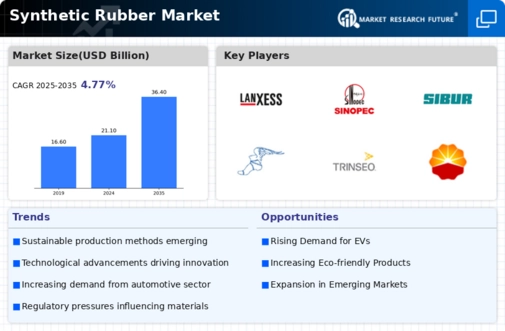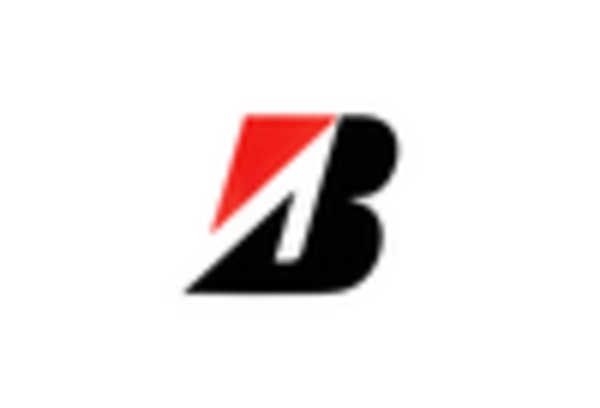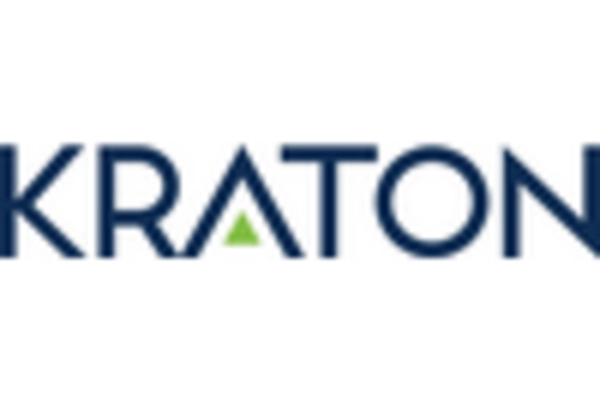-
EXECUTIVE SUMMARY 17
-
MARKET ATTRACTIVENESS
-
ANALYSIS 19
-
GLOBAL SYNTHETIC RUBBER MARKET, BY TYPE 20
-
GLOBAL SYNTHETIC RUBBER MARKET, BY APPLICATION
-
GLOBAL
-
SYNTHETIC RUBBER MARKET, BY REGION 22
-
MARKET INTRODUCTION 23
-
DEFINITION 23
-
SCOPE OF THE STUDY 23
-
MARKET STRUCTURE 24
-
RESEARCH METHODOLOGY 25
-
RESEARCH PROCESS 25
-
PRIMARY RESEARCH 26
-
SECONDARY RESEARCH 27
-
MARKET SIZE ESTIMATION 27
-
TOP-DOWN AND BOTTOM-UP APPROACHES 28
-
FORECAST MODEL 29
-
LIST OF ASSUMPTIONS
- USE OF SYNTHETIC RUBBER FOR CONSTRUCTION PURPOSES
-
& LIMITATIONS 30
-
MARKET DYNAMICS 31
-
INTRODUCTION 31
-
DRIVERS 33
-
INCREASING USE OF SYNTHETIC RUBBER IN TIRE MANUFACTURING 33
-
RESTRAINTS
- STRINGENT
-
REGULATIONS AND ADVERSE EFFECTS ASSOCIATED WITH RUBBER PROCESSING 35
-
OPPORTUNITIES 36
- DEVULCANIZATION
-
OF SYNTHETIC RUBBER 36
-
USE OF END-OF-LIFE TIRES FOR STORABLE ENERGY CARRIERS AND TIRE-DERIVED FUEL 37
-
CHALLENGES 37
- VOLATILE RAW MATERIAL
-
PRICES 37
-
MARKET FACTOR ANALYSIS 39
-
SUPPLY CHAIN ANALYSIS 39
- RAW MATERIAL SUPPLIERS 40
- SYNTHETIC RUBBER PRODUCERS
- DISTRIBUTION
- APPLICATIONS 41
-
& SALES CHANNELS 41
-
PORTER’S FIVE FORCES ANALYSIS 42
- THREAT OF NEW ENTRANTS
- BARGAINING
- BARGAINING POWER OF BUYERS 43
- INTENSITY OF RIVALRY 43
-
POWER OF SUPPLIERS 43
-
THREAT OF SUBSTITUTES 43
-
PRICING OVERVIEW 44
-
IMPACT OF COVID 19 OUTBREAK ON GLOBAL SYNTHETIC
- IMPACT ON SUUPLY CHAIN OF SYNTHETIC RUBBER MARKET 45
- QUALITATIVE ANALYSIS
-
RUBBER MARKET 45
-
IMPACT ON GLOBAL ECONOMY 45
-
ON CHANGES IN DEMAND FROM END USERS 45
-
GLOBAL SYNTHETIC RUBBER MARKET, BY TYPE 46
-
OVERVIEW 46
- GLOBAL SYNTHETIC RUBBER
- GLOBAL SYNTHETIC RUBBER MARKET ESTIMATES &
-
MARKET ESTIMATES & FORECAST BY TYPE, 2019 TO 2030 46
-
FORECAST BY TYPE, 2019 TO 2030 47
-
STYRENE-BUTADIENE RUBBER (SBR) 48
- STYRENE-BUTADIENE RUBBER (SBR) MARKET ESTIMATES
-
& FORECAST BY REGION,2019 TO 2030 48
-
ETHYLENE PROPYLENE DIENE MONOMER (EPDM) 49
- ETHYLENE PROPYLENE
-
DIENE MONOMER (EPDM) MARKET ESTIMATES & FORECAST BY REGION,2019 TO 2030 49
-
BUTYL RUBBER 50
- BUTYL RUBBER MARKET
-
ESTIMATES & FORECAST BY REGION,2019 TO 2030 50
-
POLYISOPRENE 51
- POLYISOPRENE MARKET ESTIMATES & FORECAST
-
BY REGION,2019 TO 2030 51
-
OTHERS 52
- OTHERS MARKET ESTIMATES & FORECAST BY REGION,2019 TO 2030
-
GLOBAL
-
SYNTHETIC RUBBER MARKET, BY APPLICATION 53
-
OVERVIEW 53
- GLOBAL SYNTHETIC RUBBER MARKET ESTIMATES &
- GLOBAL SYNTHETIC RUBBER MARKET ESTIMATES & FORECAST
-
FORECAST BY APPLICATION, 2019 TO 2030 53
-
BY APPLICATION, 2019 TO 2030 54
-
CONSTRUCTION 55
- CONSTRUCTION: MARKET ESTIMATES & FORECAST BY REGION,2019
- AUTOMOTIVE & TRANSPORTATION MARKET ESTIMATES &
-
TO 2030 55
-
AUTOMOTIVE & TRANSPORTATION 56
-
FORECAST BY REGION, 2019 TO 2030 56
-
MEDICAL 57
- MEDICAL: MARKET ESTIMATES & FORECAST BY REGION,2019
-
TO 2030 57
-
OTHERS 58
-
OTHERS: MARKET ESTIMATES & FORECAST BY REGION,2019 TO 2030 58
-
GLOBAL SYNTHETIC RUBBER MARKET,
-
BY REGION 59
-
OVERVIEW 59
-
NORTH AMERICA 62
-
US 65
-
CANADA 67
-
EUROPE 69
-
GERMANY 72
-
UK 74
-
FRANCE 76
-
SPAIN 78
-
ITALY 80
-
RUSSIA 82
-
REST OF EUROPE 84
-
ASIA-PACIFIC 86
-
CHINA 89
-
JAPAN 91
-
INDIA 93
-
SOUTH KOREA 95
-
AUSTRALIA & NEW ZEALAND 97
-
COUNTRIES 115
-
TURKEY 117
-
SOUTH AFRICA 119
-
REST OF THE MIDDLE EAST & AFRICA 121
-
REST OF ASIA-PACIFIC 99
-
LATIN AMERICA 101
- BRAZIL 104
- MEXICO 106
- ARGENTINA 108
- REST OF LATIN AMERICA 110
-
MIDDLE EAST & AFRICA
- GCC
-
COMPETITIVE LANDSCAPE 123
-
MARKET INTRODUCTION 123
-
GLOBAL MARKET STRATEGY ANALYSIS 123
-
RECENT DEVELOPMENTS
-
COMPETITIVE
- COMPANY OVERVIEW 130
- FINANCIAL OVERVIEW 130
- PRODUCTS OFFERED 131
- KEY DEVELOPMENTS 131
- SWOT ANALYSIS 132
- KEY STRATEGIES 132
-
BENCHMARKING 125
-
COMPANY PROFILES 127
-
LANXESS 127
-
COMPANY OVERVIEW 127
-
FINANCIAL OVERVIEW 128
-
PRODUCTS OFFERED 128
-
KEY DEVELOPMENTS 129
-
SWOT ANALYSIS 129
-
KEY STRATEGIES 129
-
KUMHO PETROCHEMICAL CO., LTD 130
-
LG CHEM LTD 133
- COMPANY OVERVIEW 133
- FINANCIAL OVERVIEW 133
- PRODUCTS OFFERED 134
- KEY DEVELOPMENTS 134
- SWOT ANALYSIS 134
- KEY STRATEGIES 134
-
SINOPEC 135
- COMPANY OVERVIEW 135
- FINANCIAL OVERVIEW 136
- PRODUCTS OFFERED 137
- KEY DEVELOPMENTS 137
- SWOT ANALYSIS 138
- KEY STRATEGIES 138
-
VERSALIS SPA. 139
- COMPANY OVERVIEW 139
- FINANCIAL OVERVIEW 140
- PRODUCTS OFFERED 141
- KEY DEVELOPMENTS 141
- SWOT ANALYSIS 142
- KEY STRATEGIES 142
-
TSRC CORPORATION 143
- COMPANY OVERVIEW 143
- FINANCIAL OVERVIEW 144
- PRODUCTS OFFERED 145
- KEY DEVELOPMENTS 145
- SWOT ANALYSIS 146
- KEY STRATEGIES 146
-
ZEON CORPORATION 147
- COMPANY OVERVIEW 147
- FINANCIAL OVERVIEW 147
- PRODUCTS OFFERED 147
- KEY DEVELOPMENTS 148
- SWOT ANALYSIS 148
- KEY STRATEGIES 148
-
GROUP DYNASOL 149
- COMPANY OVERVIEW 149
- FINANCIAL OVERVIEW 149
- PRODUCTS OFFERED 149
- KEY DEVELOPMENTS 150
- SWOT ANALYSIS 151
- KEY STRATEGIES 151
-
KRATON CORPORATION 152
- COMPANY OVERVIEW 152
- FINANCIAL OVERVIEW 153
- PRODUCTS OFFERED 154
- KEY DEVELOPMENTS 154
- SWOT ANALYSIS 155
- KEY STRATEGIES 155
-
JSR CORPORATION 156
- COMPANY OVERVIEW 156
- FINANCIAL OVERVIEW 157
- PRODUCTS OFFERED 158
- KEY DEVELOPMENTS
- COMPANY OVERVIEW 160
- FINANCIAL OVERVIEW 161
- PRODUCTS OFFERED 162
- KEY DEVELOPMENTS
- COMPANY OVERVIEW 168
- FINANCIAL OVERVIEW 169
- PRODUCTS OFFERED 170
- KEY DEVELOPMENTS
-
SWOT ANALYSIS 159
-
KEY STRATEGIES 159
-
PJSC NIZHNEKAMSKNEFTEKHIM 160
-
SWOT ANALYSIS 163
-
KEY STRATEGIES 163
-
SIBUR 164
-
COMPANY OVERVIEW 164
-
FINANCIAL OVERVIEW 165
-
PRODUCTS OFFERED 166
-
KEY DEVELOPMENTS 166
-
SWOT ANALYSIS 167
-
KEY STRATEGIES 167
-
THE GOODYEAR TIRE & RUBBER COMPANY 168
-
SWOT ANALYSIS 171
-
KEY STRATEGIES 171
-
TRINSEO 172
-
COMPANY OVERVIEW 172
-
FINANCIAL OVERVIEW 173
-
PRODUCTS OFFERED 173
-
KEY DEVELOPMENTS 174
-
SWOT ANALYSIS 174
-
KEY STRATEGIES 174
-
PETROCHINA 175
-
COMPANY OVERVIEW 175
-
FINANCIAL OVERVIEW 176
-
PRODUCTS OFFERED 176
-
KEY DEVELOPMENTS 177
-
SWOT ANALYSIS 177
-
KEY STRATEGIES 177
-
APPENDIX 178
-
REFERENCES 178
-
RELATED REPORTS 179
-
-
LIST OF TABLES
-
LIST OF ASSUMPTIONS
-
& LIMITATIONS 30
-
TABLE
-
PRICING OVERVIEW, BY REGION (USD/TONS) 44
-
GLOBAL SYNTHETIC RUBBER MARKET ESTIMATES
-
& FORECAST, BY TYPE, 2019 TO 2030 (USD MILLION) 46
-
GLOBAL SYNTHETIC RUBBER MARKET ESTIMATES
-
& FORECAST, BY TYPE, 2019 TO 2030 (KILO TONS) 47
-
STYRENE-BUTADIENE RUBBER (SBR) MARKET ESTIMATES
-
& FORECAST, BY REGION, 2019 TO 2030 (USD MILLION) 48
-
STYRENE-BUTADIENE RUBBER (SBR) MARKET ESTIMATES
-
& FORECAST, BY REGION, 2019 TO 2030 (KILO TONS) 48
-
ETHYLENE PROPYLENE DIENE MONOMER (EPDM) MARKET
-
ESTIMATES & FORECAST, BY REGION, 2019 TO 2030 (USD MILLION) 49
-
ETHYLENE PROPYLENE DIENE
-
MONOMER (EPDM) MARKET ESTIMATES & FORECAST, BY REGION, 2019 TO 2030 (KILO TONS)
-
TABLE 9
-
BUTYL RUBBER MARKET ESTIMATES & FORECAST, BY REGION, 2019 TO 2030 (USD MILLION)
-
TABLE 10
-
BUTYL RUBBER MARKET ESTIMATES & FORECAST, BY REGION, 2019 TO 2030 (KILO TONS)
-
TABLE 11
-
POLYISOPRENE MARKET ESTIMATES & FORECAST, BY REGION, 2019 TO 2030 (USD MILLION)
-
TABLE 12
-
POLYISOPRENE MARKET ESTIMATES & FORECAST, BY REGION, 2019 TO 2030 (KILO TONS)
-
TABLE 13
-
OTHERS MARKET ESTIMATES & FORECAST, BY REGION, 2019 TO 2030 (USD MILLION) 52
-
OTHERS MARKET
-
ESTIMATES & FORECAST, BY REGION, 2019 TO 2030 (KILO TONS) 52
-
GLOBAL SYNTHETIC RUBBER
-
MARKET ESTIMATES & FORECAST, BY APPLICATION, 2019 TO 2030 (USD MILLION) 53
-
GLOBAL SYNTHETIC
-
RUBBER MARKET ESTIMATES & FORECAST, BY APPLICATION, 2019 TO 2030 (KILO TONS)
-
TABLE 17
-
CONSTRUCTION MARKET ESTIMATES & FORECAST, BY REGION, 2019 TO 2030 (USD MILLION)
-
TABLE 18
-
CONSTRUCTION MARKET ESTIMATES & FORECAST, BY REGION, 2019 TO 2030 (KILO TONS)
-
TABLE 19
-
AUTOMOTIVE & TRANSPORTATION MARKET ESTIMATES & FORECAST, BY REGION, 2019
-
TO 2030 (USD MILLION) 56
-
AUTOMOTIVE & TRANSPORTATION MARKET ESTIMATES & FORECAST,
-
BY REGION, 2019 TO 2030 (KILO TONS) 56
-
MEDICAL MARKET ESTIMATES & FORECAST, BY REGION,
-
MEDICAL MARKET ESTIMATES & FORECAST, BY REGION, 2019 TO
-
TABLE
-
OTHERS MARKET ESTIMATES & FORECAST, BY REGION, 2019 TO 2030 (USD MILLION)
-
TABLE 24
-
OTHERS MARKET ESTIMATES & FORECAST, BY REGION, 2019 TO 2030 (KILO TONS) 58
-
GLOBAL SYNTHETIC
-
RUBBER MARKET, BY REGION, 2019 TO 2030 (USD MILLION) 60
-
GLOBAL SYNTHETIC RUBBER MARKET, BY REGION,
-
NORTH AMERICA: GLOBAL SYNTHETIC RUBBER MARKET, BY COUNTRY,
-
NORTH AMERICA: GLOBAL SYNTHETIC RUBBER MARKET, BY COUNTRY,
-
NORTH AMERICA: GLOBAL SYNTHETIC RUBBER MARKET, BY TYPE, 2019
-
TO 2030 (USD MILLION) 62
-
NORTH AMERICA: GLOBAL SYNTHETIC RUBBER MARKET, BY TYPE, 2019
-
TO 2030 (KILO TONS) 63
-
TABLE
-
NORTH AMERICA: GLOBAL SYNTHETIC RUBBER MARKET, BY APPLICATION, 2019 TO 2030 (USD
-
MILLION) 63
-
TABLE
-
NORTH AMERICA: GLOBAL SYNTHETIC RUBBER MARKET, BY APPLICATION, 2019 TO 2030 (KILO
-
TONS) 64
-
TABLE
-
US: GLOBAL SYNTHETIC RUBBER MARKET, BY TYPE, 2019 TO 2030 (USD MILLION) 65
-
US: GLOBAL SYNTHETIC
-
RUBBER MARKET, BY TYPE, 2019 TO 2030 (KILO TONS) 65
-
US: GLOBAL SYNTHETIC RUBBER MARKET, BY APPLICATION,
-
US: GLOBAL SYNTHETIC RUBBER MARKET, BY APPLICATION, 2019 TO
-
TABLE
-
CANADA: GLOBAL SYNTHETIC RUBBER MARKET, BY TYPE, 2019 TO 2030 (USD MILLION) 67
-
CANADA: GLOBAL
-
SYNTHETIC RUBBER MARKET, BY TYPE, 2019 TO 2030 (KILO TONS) 67
-
CANADA: GLOBAL SYNTHETIC
-
RUBBER MARKET, BY APPLICATION, 2019 TO 2030 (USD MILLION) 68
-
CANADA: GLOBAL SYNTHETIC RUBBER MARKET,
-
BY APPLICATION, 2019 TO 2030 (KILO TONS) 68
-
EUROPE: GLOBAL SYNTHETIC RUBBER MARKET,
-
BY COUNTRY, 2019 TO 2030 (USD MILLION) 69
-
EUROPE: GLOBAL SYNTHETIC RUBBER MARKET,
-
BY COUNTRY, 2019 TO 2030 (KILO TONS) 69
-
EUROPE: GLOBAL SYNTHETIC RUBBER MARKET, BY TYPE,
-
EUROPE: GLOBAL SYNTHETIC RUBBER MARKET, BY TYPE, 2019 TO 2030
-
(KILO TONS) 70
-
TABLE
-
EUROPE: GLOBAL SYNTHETIC RUBBER MARKET, BY APPLICATION, 2019 TO 2030 (USD MILLION)
-
TABLE 46
-
EUROPE: GLOBAL SYNTHETIC RUBBER MARKET, BY APPLICATION, 2019 TO 2030 (KILO TONS)
-
TABLE 47
-
GERMANY: GLOBAL SYNTHETIC RUBBER MARKET, BY TYPE, 2019 TO 2030 (USD MILLION) 72
-
GERMANY: GLOBAL
-
SYNTHETIC RUBBER MARKET, BY TYPE, 2019 TO 2030 (KILO TONS) 72
-
GERMANY: GLOBAL SYNTHETIC
-
RUBBER MARKET, BY APPLICATION, 2019 TO 2030 (USD MILLION) 73
-
GERMANY: GLOBAL SYNTHETIC RUBBER MARKET,
-
BY APPLICATION, 2019 TO 2030 (KILO TONS) 73
-
UK: GLOBAL SYNTHETIC RUBBER MARKET, BY TYPE,
-
UK: GLOBAL SYNTHETIC RUBBER MARKET, BY TYPE, 2019 TO 2030
-
(KILO TONS) 74
-
TABLE
-
UK: GLOBAL SYNTHETIC RUBBER MARKET, BY APPLICATION, 2019 TO 2030 (USD MILLION)
-
TABLE 54
-
UK: GLOBAL SYNTHETIC RUBBER MARKET, BY APPLICATION, 2019 TO 2030 (KILO TONS) 75
-
FRANCE: GLOBAL
-
SYNTHETIC RUBBER MARKET, BY TYPE, 2019 TO 2030 (USD MILLION) 76
-
FRANCE: GLOBAL SYNTHETIC
-
RUBBER MARKET, BY TYPE, 2019 TO 2030 (KILO TONS) 76
-
FRANCE: GLOBAL SYNTHETIC RUBBER MARKET,
-
BY APPLICATION, 2019 TO 2030 (USD MILLION) 77
-
FRANCE: GLOBAL SYNTHETIC RUBBER MARKET,
-
BY APPLICATION, 2019 TO 2030 (KILO TONS) 77
-
SPAIN: GLOBAL SYNTHETIC RUBBER MARKET, BY
-
TYPE, 2019 TO 2030 (USD MILLION) 78
-
SPAIN: GLOBAL SYNTHETIC RUBBER MARKET, BY TYPE,
-
SPAIN: GLOBAL SYNTHETIC RUBBER MARKET, BY APPLICATION, 2019
-
TO 2030 (USD MILLION) 79
-
SPAIN: GLOBAL SYNTHETIC RUBBER MARKET, BY APPLICATION, 2019
-
TO 2030 (KILO TONS) 79
-
TABLE
-
ITALY: GLOBAL SYNTHETIC RUBBER MARKET, BY TYPE, 2019 TO 2030 (USD MILLION) 80
-
ITALY: GLOBAL
-
SYNTHETIC RUBBER MARKET, BY TYPE, 2019 TO 2030 (KILO TONS) 80
-
ITALY: GLOBAL SYNTHETIC
-
RUBBER MARKET, BY APPLICATION, 2019 TO 2030 (USD MILLION) 81
-
ITALY: GLOBAL SYNTHETIC RUBBER MARKET, BY
-
APPLICATION, 2019 TO 2030 (KILO TONS) 81

















Leave a Comment